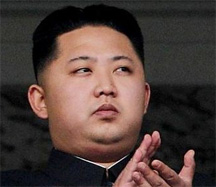BEIJING (Reuters) – North Korea plans to allow farmers to keep more of their produce in an attempt to boost agricultural output, a source with close ties to Pyongyang and Beijing said, in a move that could boost supplies, help cap rising food prices and ease malnutrition.

The move to liberalise agriculture under new leader Kim Jong-un, who took office in December 2011 after the death of his father, would reverse a crackdown on private production that started in 2005. It comes amid talk that the youngest Kim to rule the impoverished North is considering reforms to boost the economy.
“Peasants will have incentive to grow more food. They can keep and sell in the market about 30-50 per cent of their harvest depending on the region,” said the source.
At present, most farm output is sold to the government at a state auction price that has diverged from the market rate.
It was impossible to verify the plan independently in North Korea, one of the world’s most closed states, although the source has proved reliable in the past, predicting North Korea’s first nuclear test in 2006 days before it was conducted, as well as the ascent of Kim’s uncle, Jang Song-thaek.
The plans come as some websites run by North Korean defector groups have said the price of rice – a staple food – more than doubled at the end of August from the start of June.
The surge in rice prices, cited by DailyNK, a North Korean defector website (www.dailynk.com), was driven by a fear of economic reforms that could in fact be punitive, like a 2009 currency revaluation that confiscated most peoples’ savings. This report also could not be independently verified.
North Korea experienced a devastating famine in the 1990s from which its economy has not recovered, and a third of its population is malnourished, according to U.N. estimates. The country needs about 5 million tons of grain and potatoes to feed its people and since the early 1990s its annual harvest has been 3.5-4.7 million tons, according to most observers.
Experts in South Korea believe the North desperately needs fertiliser to boost yields in a country where soil has been degraded by erosion due to poor farming techniques.
Lost in translation
A recent visit to Beijing, North Korea’s sole major economic and diplomatic ally, by the youngest Kim’s uncle Jang appeared to be aimed at economic reforms in North Korea, whose centrally planned economy is smaller than it was 20 years ago.
North Korea wants to attract Chinese investment to help it overcome tough sanctions imposed in retaliation for its nuclear tests. Kim also aims to deliver on a promise to make the North a “prosperous” nation by 2012 and to banish memories of his father’s austere 17-year rule.
But it is unclear how far Kim Jong-un can go in liberalising the economy without losing his family’s firm grip on power, most independent analysts say.
The source said a Sept 25 meeting of the Supreme People’s Assembly, the North’s rubber-stamp parliament, was likely to discuss “economic adjustment”, but was unlikely to result in any major steps forward.
The phrase “economic adjustment” has been chosen carefully, the source added, noting the North’s decision not to use the old catch-cry of its key ally, China – “reform and opening up” – should not be misinterpreted as a lack of reformist will.
Instead, the source said, North Korea was indeed trying to follow in the footsteps of China but was avoiding the phrase coined by Beijing because of an unfortunate quirk of the Korean language. “It won’t be called ‘reform and opening up’ because it sounds like ‘dog fart’ in Korean,” the source said.
This is the second time this year that the parliament, which rarely meets, has been assembled this year, triggering speculation in the North Korea-watching community that it could be a forum for announcing major reforms.
The source said North Korea also planned to make its 1.2 million-strong military – one of the largest armed forces in the world – food self-reliant by modelling its production model on China’s armed forces.
“The food (shortage) problem will hopefully be resolved by learning from the Xinjiang Construction and Production Corps,” the source said, referring to the sprawling quasi-military network of state farms and factories in northwestern China intended to secure stability in the restive region by developing the economy and helping control borderlands.
The Xinjiang corps was founded in 1954 by late vice president Wang Zhen. As of March 2011, more than 2.6 million people lived in the corps’ 14 divisions, which cover a combined area of more than 70,000 sq km (27,000 sq miles). The corps owns 179 farms, 1,400 enterprises, 13 listed companies, universities, media outlets and medical institutions, and its output was worth 75 billion yuan ($11.9 billion) in 2010.
